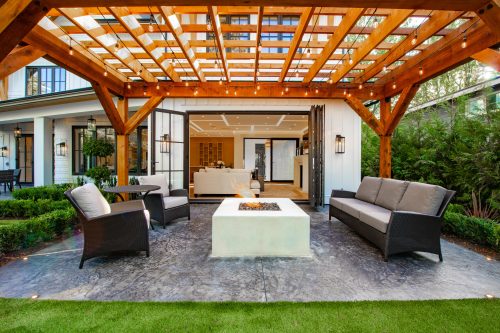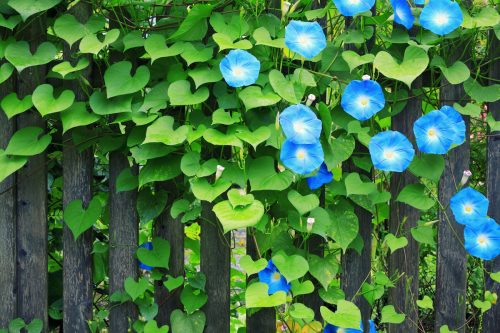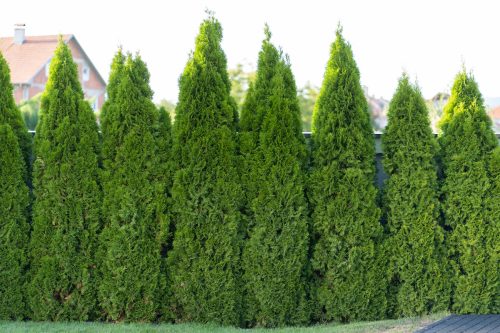5 Clever Ways to Make Your Yard More Private, Experts Say

Nosy neighbors? Live on a busy street? Or hey, maybe you’re just a private person! Whatever the case, adding privacy to your yard is an important home renovation project for many people. In some cases, you may not be able to have a fence. Or perhaps, your fence just isn’t cutting it (they can only be so tall, after all). That’s why we enlisted the help of landscape designers and garden experts to share the most clever ways to make your yard more private. Keep reading to find out how it’s done.
READ THIS NEXT: 5 Plants That Will Keep Mosquitoes Out of Your Yard, According to Pest Experts.
1
Add physical structures.

If you’re able to erect a fence in your backyard, that’s probably the most straightforward way to add privacy.
“A traditional wooden panel fence can be somewhat mundane,” says Janet Loughrey of Garden Design. Instead, she suggests painting it a fun color or even a combination of colors.
If a fence is too obstructive, is not allowed by local ordinance, or is too costly, Stephen and David St. Russell, award-winning designers and DIY experts known as the Renovation Husbands, say you have other options in terms of physical structures.
They recommend raised beds, trellises, pergolas, or arbors. Install these near or around seating and dining areas for max privacy.
2
Incorporate vines.

If you have a fence or other structure but feel that it’s still a bit lacking in privacy, experts recommend adding flowering vines.
“They’ll help shield your yard and produce beautiful flowers throughout the summer without damaging the structure,” says Rebecca Sears, CMO and resident green thumb at Ferry-Morse.
Sears likes morning glory, while Amy Hovis, principal and landscape designer at Eden Garden Design, says star jasmine “is a very hardy and fast-growing vine that grows 10-12 feet and is wonderfully fragrant.” It’s also good in sun or shade.
Of course, climbing plants like clematis or ivy are also options, notes Gene Caballero, co-founder of GreenPal.
And if you have an arbor, the St. Russells say it’s the “perfect structure for a climbing rose, creating a dense screen of green foliage well into the winter.”
READ THIS NEXT: The First Things Guests Notice About Your Backyard, According to Experts.
3
Create a living wall.

Instead of a fence, you can also create what landscape experts call a “living wall.”
“Evergreen arborvitae varieties like Green Giant and Emerald Green provide greenery and privacy year-round,” says Sears.
Hovis points to skyrocket juniper, which, as the name suggests, grows in a narrow, upright fashion.
“They are a hardy and durable evergreen shrub with gorgeous bluish or grey-green foliage,” she explains. “They provide great screening when planted in a row and require very little care, once established.” And since they’re so narrow, you can plant them close together.
Hovis also recommends wax myrtle, another fast-growing evergreen tree or shrub. “They have great glossy deep green foliage,” she says, and are hardy and drought-tolerant.
Bamboo is another option, but you’ll want to be absolutely sure you’re choosing “clumping bamboo as opposed to running bamboo so that it doesn’t spread into your yard or your neighbors’ yard,” advises Hovis. “Since bamboo requires a lot of water to get established, it is best to have irrigation installed to ensure it gets the right amount of water,” she adds.
Sears says you can also use potted flowers that grow tall. “Hollyhock, for example, can grow four to five feet tall in a container as long as it has enough space to do so,” she shares. “Sunflowers…can grow 10 to 12 feet tall once mature.”
For more home and garden advice delivered straight to your inbox, sign up for our daily newsletter.
4
Put up a sunshade sail.

Sometimes, the privacy you need is actually from above, especially if you live in a city.
“For urban spaces that are overlooked by multi-story buildings, suspend a shade sail over a patio or other seating area to create cooling shade and prevent nearby neighbors from looking down on your outdoor living space,” suggests Loughrey.
Even in suburban backyards, these are a great option if you have neighbors with a high deck or patio.
5
Use water features.

Privacy isn’t just about sightlines; it’s also about what your neighbors can hear. For this, experts say water features are the way to go.
“We find that the white noise from flowing water makes a big difference in how you perceive privacy,” share the St. Russells. “Anything from a small pond with a waterfall to a small DIY fountain created with materials you already own. Flowing water can be a lot of fun and adds so much interest while distracting you from neighboring sounds.”